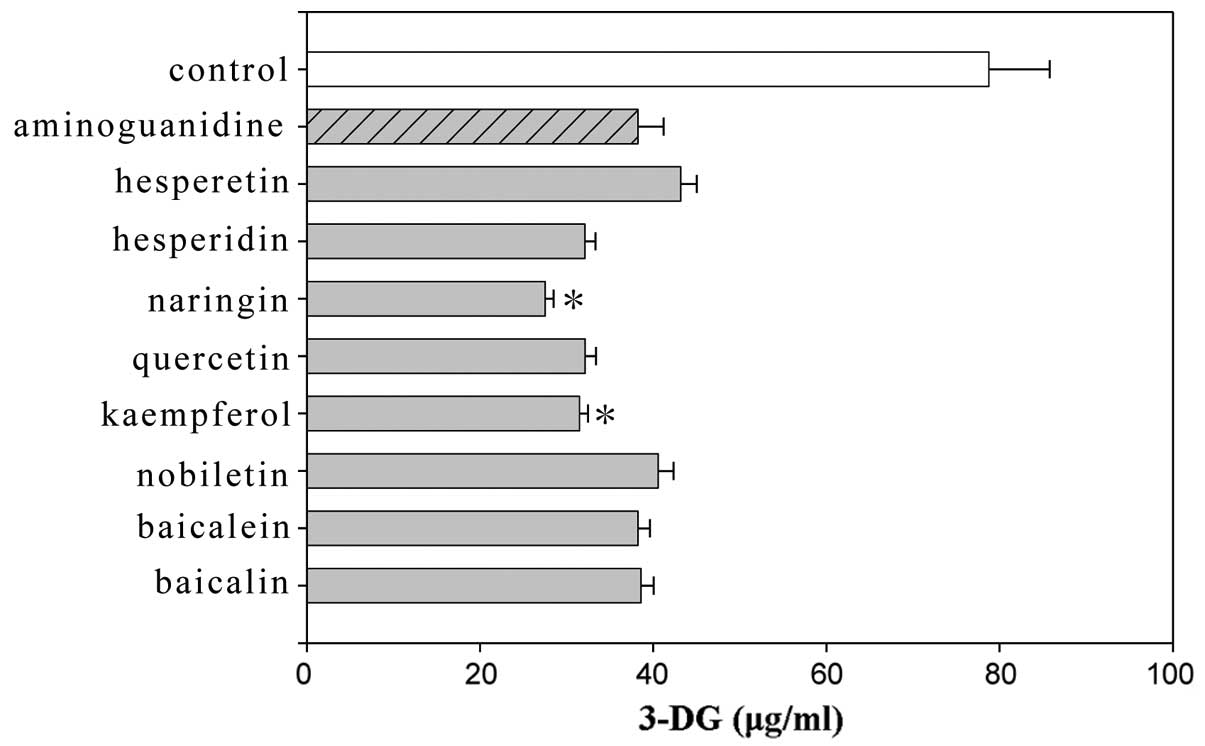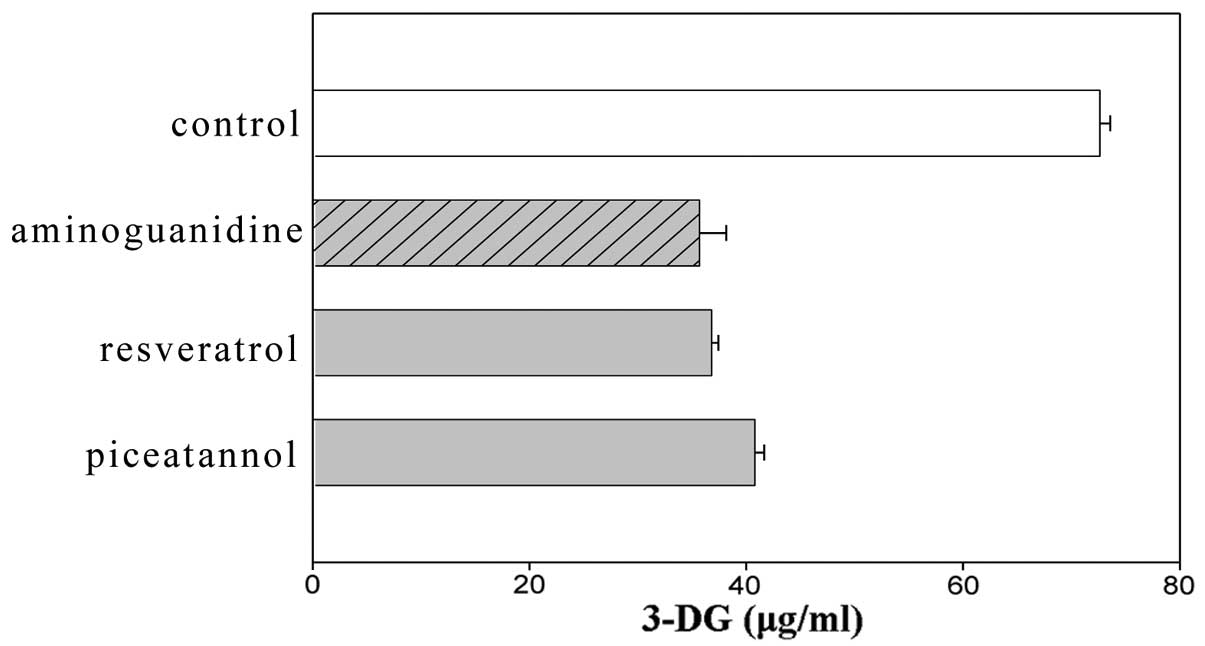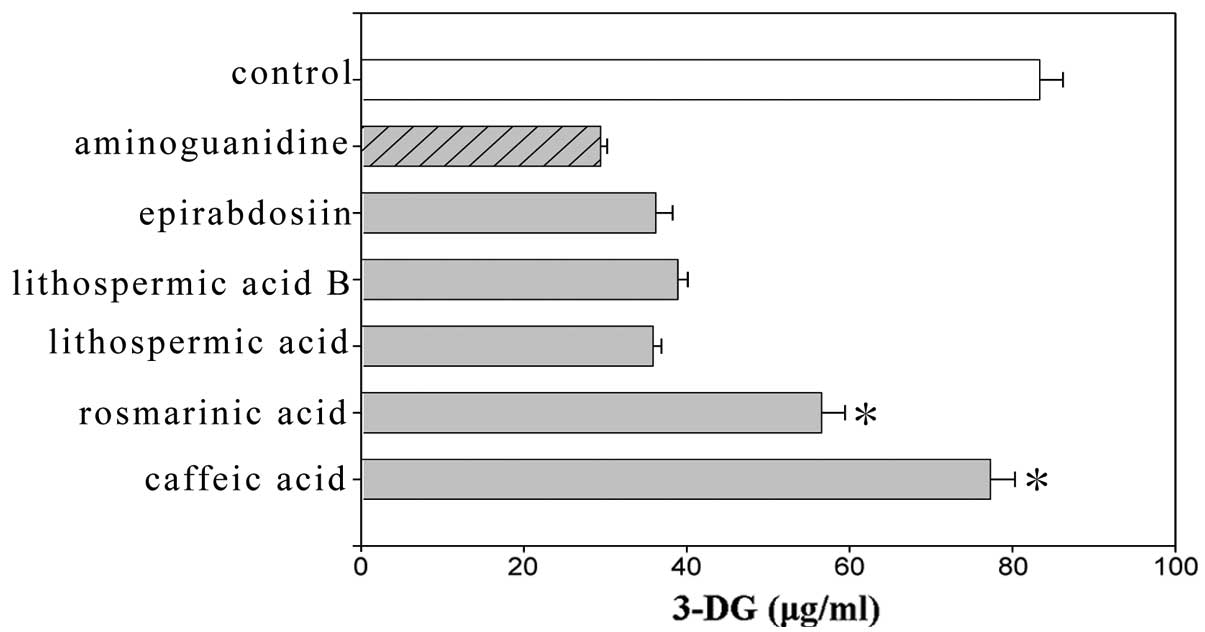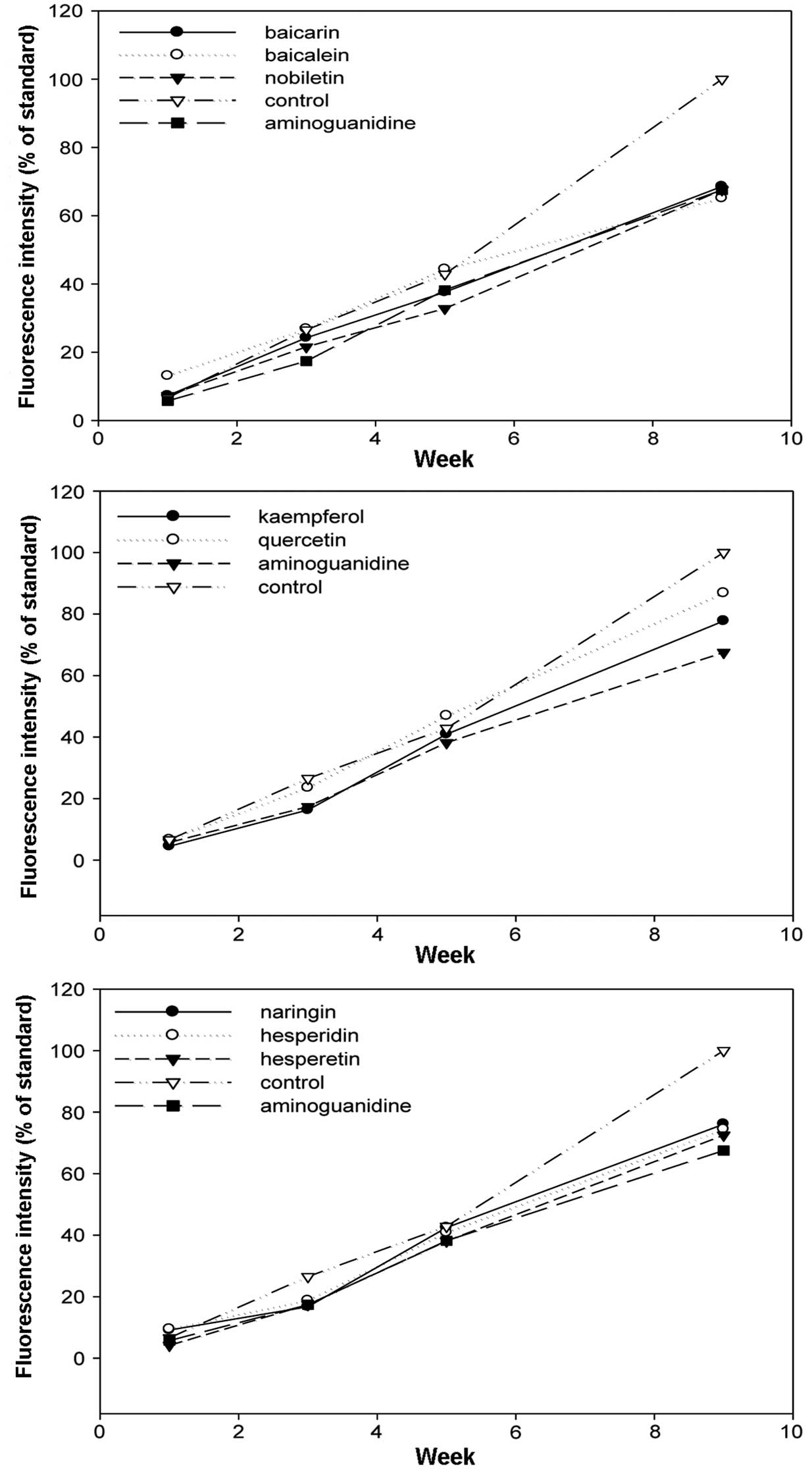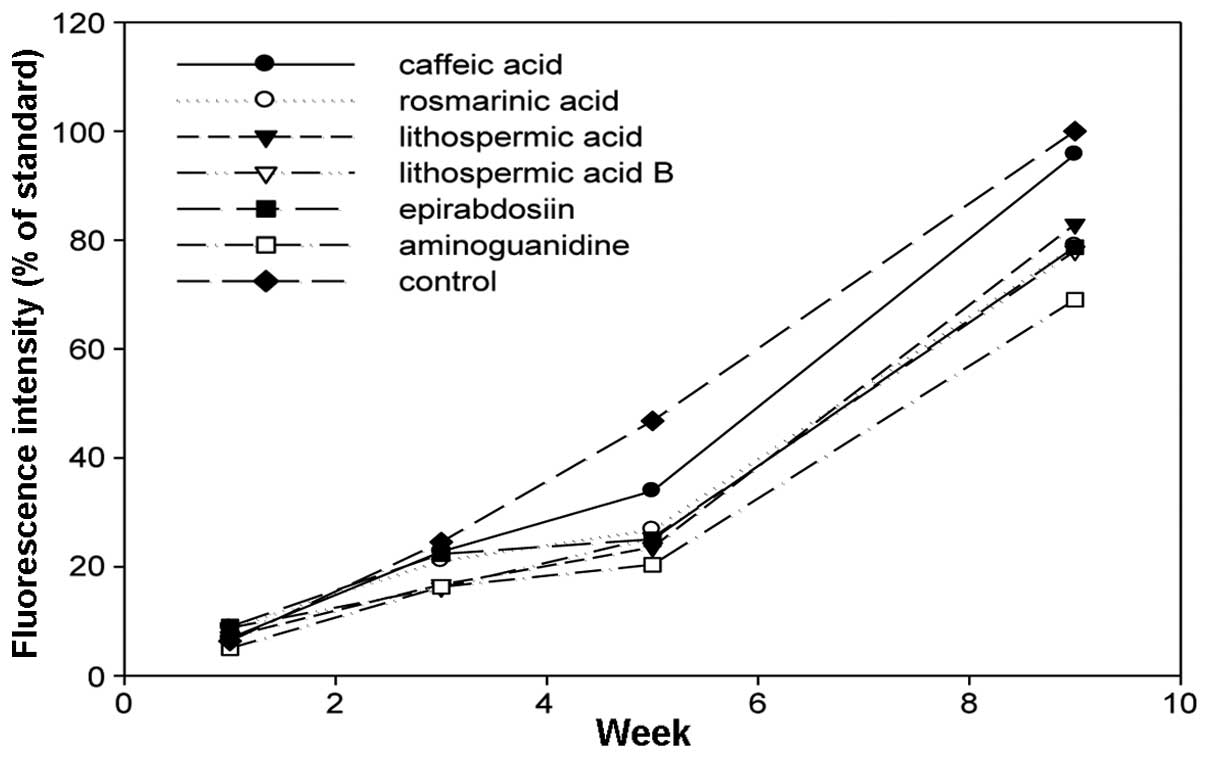|
1
|
Barlovic DP, Soro-Paavonen A and
Jandeleit-Dahm KA: RAGE biology, atherosclerosis and diabetes. Clin
Sci (Lond). 121:43–55. 2011. View Article : Google Scholar : PubMed/NCBI
|
|
2
|
Vitek MP, Bhattacharya K, Glendening JM,
Stopa E, Vlassara H, Bucala R, Manogue K and Cerami A: Advanced
glycation end products contribute to amyloidosis in Alzheimer
disease. Proc Natl Acad Sci USA. 91:4766–4770. 1994. View Article : Google Scholar : PubMed/NCBI
|
|
3
|
Sasaki N, Toki S, Chowei H, Saito T,
Nakano N, Hayashi Y, Takeuchi M and Makita Z: Immunohistochemical
distribution of the receptor for advanced glycation end products in
neurons and astrocytes in Alzheimer’s disease. Brain Res.
888:256–262. 2001.PubMed/NCBI
|
|
4
|
Sasaki N, Takeuchi M, Chowei H, Kikuchi S,
Hayashi Y, Nakano N, Ikeda H, Yamagishi S, Kitamoto T, Saito T and
Makita Z: Advanced glycation end products (AGE) and their receptor
(RAGE) in the brain of patients with Creutzfeldt-Jakob disease with
prion plaques. Neurosci Lett. 326:117–120. 2002. View Article : Google Scholar : PubMed/NCBI
|
|
5
|
Kikuchi S, Shinpo K, Ogata A, Tsuji S,
Takeuchi M, Makita Z and Tashiro K: Detection of N
epsilon-(carboxymethyl)lysine (CML) and non-CML advanced glycation
end-products in the anterior horn of amyotrophic lateral sclerosis
spinal cord. Amytroph Lateral Scler Other Motor Neuron Disord.
3:63–68. 2002. View Article : Google Scholar : PubMed/NCBI
|
|
6
|
Abe R, Shimizu T, Sugawara H, Watanabe H,
Nakamura H, Choei H, Sasaki N, Yamagishi S, Takeuchi M and Shimizu
H: Regulation of human melanoma growth and metastasis by AGE-AGE
receptor interactions. J Invest Dermatol. 122:461–467. 2004.
View Article : Google Scholar : PubMed/NCBI
|
|
7
|
Dyer DG, Blackledge JA, Thorpe SR and
Baynes JW: Formation of pentosidine during nonenzymatic browning of
proteins by glucose. Identification of glucose and other
carbohydrates as possible precursors of pentosidine in vivo. J Biol
Chem. 266:11654–11660. 1991.PubMed/NCBI
|
|
8
|
Kato H, van Chyuyen N, Shinoda T, Sekiya F
and Hayase F: Metabolism of 3-deoxyglucosone, an intermediate
compound in the Maillard reaction, administered orally or
intravenously to rats. Biochem Biophys Acta. 1035:71–76. 1990.
View Article : Google Scholar : PubMed/NCBI
|
|
9
|
Rice-Evans C, Spencer JP, Schroeter H and
Rechner AR: Bioavailability of flavonoids and potential bioactive
forms in vivo. Drug Metabol Drug Interact. 17:291–310. 2000.
View Article : Google Scholar : PubMed/NCBI
|
|
10
|
Kang GJ, Han SC, Yi EJ, Kang HK and Yoo
ES: The inhibitory effect of premature Citrus unshiu extract
on atopic dermatitis in vitro and in vivo. Toxicol Res. 27:173–180.
2011.
|
|
11
|
Baek SH, Kim SM, Nam D, Lee JH and Ahn KS,
Choi SH, Kim SH, Shim BS, Chang IM and Ahn KS: Antimetastatic
effect of nobiletin through the down-regulation of CXC chemokine
receptor type 4 and matrix metallopeptidase-9. Pharm Biol.
50:1210–1218. 2012. View Article : Google Scholar : PubMed/NCBI
|
|
12
|
Manthey JA and Guthrie N:
Antiproliferative activities of citrus flavonoids against six human
cancer cell lines. J Agric Food Chem. 50:5837–5843. 2002.
View Article : Google Scholar : PubMed/NCBI
|
|
13
|
Yamamoto H, Sakakibara J, Nagatsu A and
Sekiya K: Inhibitors of arachidonate lipoxygenase from defatted
perilla seed. J Agric Food Chem. 46:862–865. 1998. View Article : Google Scholar
|
|
14
|
Nakamura Y, Ohto Y, Murakami A and
Ohigashi H: Inhibitory effects of curcumin and
tetrahydrocurcuminoids on the tumor promoter-induced reactive
oxygen species generation in leukocytes in vitro and in vivo. Jpn J
Cancer Res. 89:361–370. 1998. View Article : Google Scholar : PubMed/NCBI
|
|
15
|
Sasaki K and Yoshizaki F: Nobiletin as a
tyrosinase inhibitor from the peel of Citrus fruit. Biol Pharm
Bull. 25:806–808. 2002. View Article : Google Scholar : PubMed/NCBI
|
|
16
|
Kobayashi K, Ishihara T, Khono E, Miyase T
and Yoshizaki F: Constituents of stem bark of Callistemon
rigidus showing inhibitory effects on mouse alpha-amylase
activity. Biol Pharm Bull. 29:1275–1277. 2006.PubMed/NCBI
|
|
17
|
Murata T, Sasaki K, Sato K, Yoshizaki F,
Yamada H, Mutoh H, Umehara K, Miyase T, Warashina T, Aoshima H, et
al: Matrix metalloproteinase-2 inhibitors from Clinopodium
chinense var. parviflorum. J Nat Prod. 72:1379–1384.
2009. View Article : Google Scholar : PubMed/NCBI
|
|
18
|
Lee SK, Mbwambo ZH, Chung H, Luyengi L,
Gamez EJ, Mehta RG, Kinghorn AD and Pezzuto JM: Evaluation of the
antioxidant potential of natural products. Comb Chem High
Throughput Screen. 1:35–46. 1998.PubMed/NCBI
|
|
19
|
Valencia JV, Weldon SC, Quinn D, Kiers GH,
DeGroot J, TeKoppele JM and Hughes TE: Advanced glycation end
product ligands for the receptor for advanced glycation end
products: biochemical characterization and formation kinetics. Anal
Biochem. 324:68–78. 2004. View Article : Google Scholar : PubMed/NCBI
|
|
20
|
Yamada H, Miyata S, Igaki N, Yatabe H,
Miyauchi Y, Ohara T, Sakai M, Shoda H, Oimomi M and Kasuga M:
Increase in 3-deoxyglucosone levels in diabetic rat plasma.
Specific in vivo determination of intermediate in advanced Maillard
reaction. J Biol Chem. 269:20275–20280. 1994.PubMed/NCBI
|
|
21
|
Edelstein D and Brownlee M: Mechanistic
studies of advanced glycosylation end product inhibition by
aminoguanidine. Diabetes. 41:26–29. 1992. View Article : Google Scholar : PubMed/NCBI
|
|
22
|
Sady C, Khosrof S and Nagaraj R: Advanced
Maillard reaction and crosslinking of corneal collagen in diabetes.
Biochem Biophys Res Commun. 214:793–797. 1995. View Article : Google Scholar : PubMed/NCBI
|
|
23
|
Ahmed MU, Thorpe SR and Baynes JW:
Identification of N epsilon-carboxymethyllysine as a degradation
product of fructoselysine in glycated protein. J Biol Chem.
261:4889–4894. 1986.PubMed/NCBI
|
|
24
|
Reddy S, Bichler J, Wells-Knecht KJ,
Thorpe SR and Baynes JW: N epsilon-(carboxymethyl)lysine is a
dominant advanced glycation end product (AGE) antigen in tissue
proteins. Biochemistry. 34:10872–10878. 1995. View Article : Google Scholar : PubMed/NCBI
|
|
25
|
Thornalley PJ, Langborg A and Minhas HS:
Formation of glyoxal, methylglyoxal and 3-deoxyglucosone in the
glycation of proteins by glucose. Biochem J. 344:109–116. 1999.
View Article : Google Scholar : PubMed/NCBI
|
|
26
|
Wei J, Jin F, Wu Q, Jiang Y, Gao D and Liu
H: Molecular interaction study of flavonoid derivative 3d with
human serum albumin using multispectroscopic and molecular modeling
approach. Talanta. 126:116–121. 2014. View Article : Google Scholar : PubMed/NCBI
|
|
27
|
Richard T, Lefeuvre D, Descendit A,
Quideau S and Monti JP: Recognition characters in
peptide-polyphenol complex formation. Biochim Biophys Acta.
1760:951–958. 2006. View Article : Google Scholar : PubMed/NCBI
|



